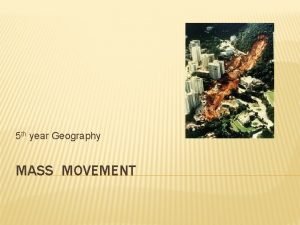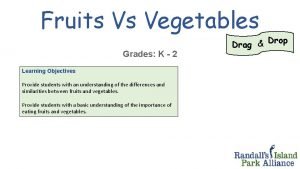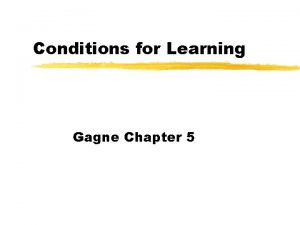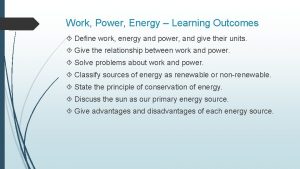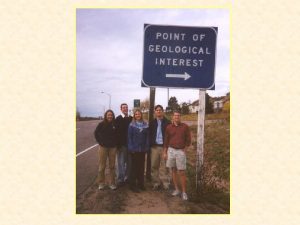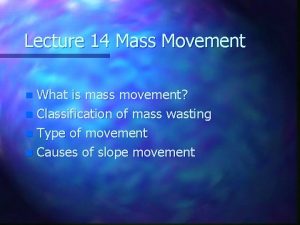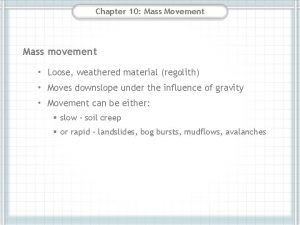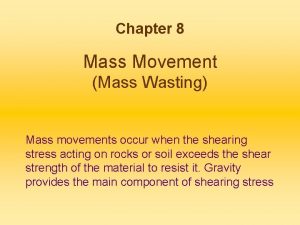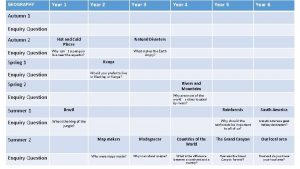5 th year Geography MASS MOVEMENT LEARNING OUTCOMES

































- Slides: 33

5 th year Geography MASS MOVEMENT

LEARNING OUTCOMES �Causes of Mass Movement �Different types of Mass Movement �Case Studies of Mass Movement �Impact of Human Activities on Mass Movement

MASS MOVEMENT � The movement of material downhill under the influence of gravity. � The loose material is called regolith.

TRIGGERS OF MASS MOVEMENT � Natural Torrential rain � Heavy snow � Earthquakes � Volcanoes � � Human Road building across hills and mountains � Waste being piled on unstable slopes � Quarry blasting � Deforestation � Skiing �

FACTORS AFFECTING MASS MOVEMENT � Gravity � Slope � Water � Vegetation � Human Activities � Type of Material

CLASSIFYING MASS MOVEMENTS � Can be grouped according to; �Speed �Water Content

TYPES OF MASS MOVEMENT � Very Slow � Soil Creep � Solifluction � Fast and Wet � Mudflows � Bogbursts � Lahars � Fast and Dry � Rock Falls � Avalanches � Landslides � Slumps

CHAPTER 10: MASS MOVEMENT Soil creep § § § Very slow movement Underlying rock becomes heavily saturated following periods of heavy rainfall Water can no longer pass through the rock Soil particles expand later contract when they dry out Causes soil particles to creep slowly downhill under the influence of gravity

SOIL CREEP

2. Slump-rotational slide § § § § Loosely consolidated rock layers moves down slope Influence of gravity Moderate speed May be an isolated occurrence or they may occur in large areas Often associated with areas which have been affected by human activities E. g. during the construction of roads where the land has been too steepened and has been left unstable Also linked to coasts and river banks where, due to erosion, slopes have been undercut Also associated with landscapes following heavy rain

3. Earthflow § Water saturated material (fine sand, silt and clay) flows downslope § Influence of gravity § Moderate speed § Generally occur on hilly slopes § Associated with heavy rain § Speed at which they travel varies from several cm per year to hundreds of metres per day § More common in humid areas § Tend to have a lower water content than mudflows

4. Rockfall § Rocks fall downslope § Influence of gravity § Rapid speed § Occur following periods of heavy rain and frost weathering § Strong earthquakes may also cause rock falls to occur § Caused by either a biological or a climatic event changing rock stability

ROCK FALL

5. § § § Debris avalanche Movement of rocks, soil and debris mixed with ice or water or both Rapid movement Material transported liquefies Rapid speed Can move further than the foot of a slope due to their rapid speed

6. § § § § Mudflow Saturated regolith flows rapidly downslope Influence of gravity Associated with steep slopes and deep soils Fast speed Soil becomes waterlogged and saturated if there is an impermeable rock layer beneath Can be of speeds in excess of 100 km per hour Can occur as a result of volcanic activity – known as lahars Volcano with snow on its top erupts, the melting snow and ice cause a mudflow

CHAPTER 10: MASS MOVEMENT Mudflow case study § 15 June 1991, Mount Pinatubo, Philippines § Volcanic eruption deposited more than 5 cubic kilometers of volcanic ash and rock fragments on the volcano slopes § Heavy rains washed this material down into the surrounding lowlands in giant, fast-moving lahars § The next four rainy season’s lahars carried about half of the deposits off the volcano, causing even more destruction in the lowlands

Bogburst § § § An area of bog moves downslope Influence of gravity Slow to fast speed Tend to occur mostly during autumn and winter due to high precipitation levels Periods of very heavy rain after long periods of very dry weather seem to be associated with the occurrence of bog bursts Human activity is also linked to the occurrence of bog bursts, e. g. peat cutting, draining of land for agriculture and the construction of wind farms

CHAPTER 10: MASS MOVEMENT Bogburst case study § Derrybrien, Slieve Aughty Mountains, Co. Galway § 16 October 2003: bog had been affected by a dry spell during the summer and when heavy rain fell, the peat became saturated § Resulted in local roads being closed § Lough Cutra river system was polluted § Thousands of fish killed when some 70 acres of bogland flowed down river § Triggers- Human Activity & Heavy Rain



Avalanche § § § Very rapid movement of snow downslope May occur due to either natural events or human activity Fast speed Usually occur on mountain slopes Occur when the weight of the snow is too much for the slope to hold

AVALANCHE

Major causes of avalanches may include the following: 1. 2. 3. 4. 5. 6. 7. Weather – they are most likely to occur after a heavy snowstorm Snowfall – recent snowfall exerts increased pressure on existing snow deposits Temperature – warmer temperatures experienced over several days may cause upper layers of snow to melt and weaken Wind direction – snow may be packed unevenly on the leeward side of a mountain due to prevailing wind direction Slope angle – most avalanches occur on slopes of between 30 and 45 degrees Slope orientation – most avalanches occur on slopes facing north, north-east and east Human activities – deforestation and tourist activity may lead to the occurrence of avalanches

9. Landslide § § § Slope stability changes from stable to unstable Causes may be loss of vegetation, erosion of slope, weakening of slope, earthquake activity, volcanic eruptions and human activities Fast speed

DAMAGE CAUSED DURING BRAZILIAN LANDSLIDES (JAN 2011)



Human activities can impact on the operation of surface processes § § § Impact of overgrazing Impact of overcropping Impact of deforestation

Sahel case study § Areas that are most affected by desertification are regions/areas that are on the edges of deserts § Sahel Region lies to the Southern end of the Sahara Desert in Africa § Covers an area of approximately 1000 km in total § Stretches from the Atlantic Ocean coast to the Red Sea coast and is located at the southern end of the Sahara desert § Desert is growing at a rapid rate § Experienced an increase in population in recent years

Sahel case study (continued) § High birth rate and immigration rates are also high § High population growth increases the demand for food § Increased demand for food and for land to cultivate § Growth of farming and cultivation has led to soil becoming exhausted and exposed to erosion § Increase in the number of animals required for food has also resulted in overgrazing § Cattle are also seen as a sign of wealth in the region. § Energy needs are satisfied by cutting down trees

CHAPTER 10: MASS MOVEMENT Sahel case study (continued) § Vegetation, along with the trees, bind the soil together § When removed, the soil becomes weak and dry § When extra land is needed, a practice of ‘slash and burn’ has been used and has increased the barrenness of the region § The Sahel Region has experienced long periods of drought § Also experiences spots of unpredictable heavy rainfall § This type of rain can damage crops § When land experiences desertification, fertility is reduced and this has a direct effect on food supply; it may lead to famines

VIDEO CLIP �Saharan �Millions Desertification of years ago the Sahara was a green and pleasant land, but over the centuries desertification changed its climate.

EXAM QUESTIONS � Examine how human processes can impact on the process of mass movement. (30 m) � Describe and explain any one process of mass movement. (30 m)
 Mass movement definition geography
Mass movement definition geography Ancient rome outcomes geography and early republic
Ancient rome outcomes geography and early republic Learning outcomes examples
Learning outcomes examples Learning outcomes of water cycle
Learning outcomes of water cycle Objectives of notice writing
Objectives of notice writing What is the objective of swot analysis
What is the objective of swot analysis Importance of nursery rhymes
Importance of nursery rhymes Example of learning objectives
Example of learning objectives Photosynthesis takes place in the
Photosynthesis takes place in the Learning outcomes of nutrition in plants
Learning outcomes of nutrition in plants What is ncbts
What is ncbts Learning outcomes of linear equations in one variable
Learning outcomes of linear equations in one variable Learning outcome generator
Learning outcome generator Reported speech learning objectives
Reported speech learning objectives Purpose of learning outcomes
Purpose of learning outcomes Output devices purpose
Output devices purpose Biological level of analysis
Biological level of analysis Reflective essay on learning outcomes
Reflective essay on learning outcomes Learning outcomes of holy week
Learning outcomes of holy week What is easter
What is easter Head start early learning outcomes framework
Head start early learning outcomes framework Learning outcomes of vegetables
Learning outcomes of vegetables Gagne learning outcomes
Gagne learning outcomes Mind map of arithmetic progression
Mind map of arithmetic progression The chappals were given to the beggar because
The chappals were given to the beggar because Sound energy definition
Sound energy definition Sales and revenue are the same
Sales and revenue are the same Cooking learning outcomes
Cooking learning outcomes 7 domains of ppst and strands
7 domains of ppst and strands Learning outcomes prescribe:
Learning outcomes prescribe: Learning outcomes of work and energy
Learning outcomes of work and energy Cas learning outcomes
Cas learning outcomes Conclusion of learning outcomes
Conclusion of learning outcomes State pythagoras theorem
State pythagoras theorem
